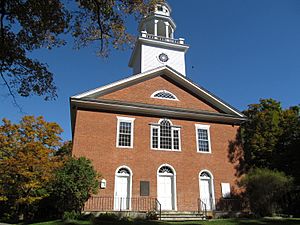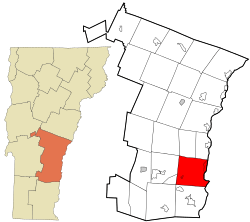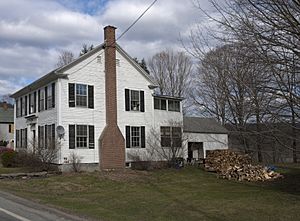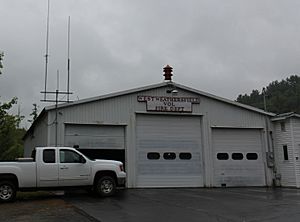Weathersfield, Vermont facts for kids
Quick facts for kids
Weathersfield, Vermont
|
|
|---|---|
 |
|

Location in Windsor County and the state of Vermont.
|
|
| Country | United States |
| State | Vermont |
| County | Windsor |
| Communities |
|
| Area | |
| • Total | 44.2 sq mi (114.5 km2) |
| • Land | 43.6 sq mi (113.0 km2) |
| • Water | 0.6 sq mi (1.5 km2) |
| Elevation | 1,237 ft (377 m) |
| Population
(2020)
|
|
| • Total | 2,842 |
| • Density | 64.29/sq mi (24.821/km2) |
| Time zone | UTC-5 (Eastern (EST)) |
| • Summer (DST) | UTC-4 (EDT) |
| ZIP Codes | |
| Area code(s) | 802 |
| FIPS code | 50-77500 |
| GNIS feature ID | 1462247 |
Weathersfield is a town located in Windsor County, Vermont, United States. In 2020, about 2,842 people lived there.
Contents
History of Weathersfield
The town of Weathersfield got its name from Wethersfield, Connecticut. This was the hometown of some of its first settlers. The Connecticut town was named after a village in English county of Essex.
William Jarvis and Merino Sheep
William Jarvis was a special representative for the U.S. in Portugal, chosen by President Thomas Jefferson. In 1811, Jarvis brought the very first Merino sheep to America from Spain. He brought them to his farm in Weathersfield Bow.
Jarvis even gave eight of his 4,000 Merino sheep as gifts to former President Jefferson and to President James Madison. Jarvis was a successful businessman and farmer. His introduction of Merino sheep was very important for Vermont's farming for the next 100 years.
Jarvis married Mary Pepperell Sparhawk. Their daughter, Katherine L. Jarvis, married Leavitt Hunt. He was a lawyer and photographer. Leavitt Hunt and his wife lived in Weathersfield at their home, Elmsholme.
Another important person who lived in Weathersfield was Rev. John Dudley. He was a preacher and a missionary to the Choctaw Indians. His son, William Wade Dudley, who became a politician, was born in Weathersfield.
On August 20, 2011, Weathersfield celebrated its 250th anniversary. This marked 250 years since the town was officially created.
Romaine Tenney's Story
In 1964, a farmer named Romaine Tenney lived in Weathersfield. He was very determined not to let Interstate 91 be built through his farm. The state offered money for his land, but he refused.
Many landowners didn't want to sell their land. Romaine Tenney was the last one in the area to hold out. He was finally told he had to leave. That night, his barn, sheds, and farmhouse burned down. It seemed he had locked himself in his bedroom.
After his memorial service, construction on the highway continued. Tenney's story became famous through poems, ghost stories, and songs. For some, his strong will became a source of local pride.
His farm eventually became a park and ride area. This is where people can park their cars and take buses. In 2020, the last tree from his farm was removed. The state transportation agency recognized the spot as the Romaine Tenney Memorial Park. It now has a lawn, a shelter, a plaque, and a picnic table.
Geography

Weathersfield covers about 114.5 square kilometers (44.2 square miles). Most of this area is land, and a small part is water. The town includes the village of Perkinsville.
Population and People
| Historical population | |||
|---|---|---|---|
| Census | Pop. | %± | |
| 1790 | 1,146 | — | |
| 1800 | 1,944 | 69.6% | |
| 1810 | 2,115 | 8.8% | |
| 1820 | 2,301 | 8.8% | |
| 1830 | 2,213 | −3.8% | |
| 1840 | 2,002 | −9.5% | |
| 1850 | 1,851 | −7.5% | |
| 1860 | 1,765 | −4.6% | |
| 1870 | 1,557 | −11.8% | |
| 1880 | 1,354 | −13.0% | |
| 1890 | 1,174 | −13.3% | |
| 1900 | 1,089 | −7.2% | |
| 1910 | 1,092 | 0.3% | |
| 1920 | 1,087 | −0.5% | |
| 1930 | 1,156 | 6.3% | |
| 1940 | 1,075 | −7.0% | |
| 1950 | 1,288 | 19.8% | |
| 1960 | 1,254 | −2.6% | |
| 1970 | 2,040 | 62.7% | |
| 1980 | 2,534 | 24.2% | |
| 1990 | 2,674 | 5.5% | |
| 2000 | 2,788 | 4.3% | |
| 2010 | 2,825 | 1.3% | |
| 2020 | 2,842 | 0.6% | |
| U.S. Decennial Census | |||
In 2000, there were 2,788 people living in Weathersfield. Most people were White (98.57%). About 26.2% of households had children under 18. The average age of people in the town was 44 years old.
Arts and Culture
Places to Visit
Weathersfield has several historic buildings. These are found in the Weathersfield Center Historic District. You can visit the Reverend Dan Foster House, the Weathersfield Meeting House, and the First Congregational Church.
The Reverend Dan Foster House is now a museum. It is run by the Weathersfield Historical Society. The house was built during the Revolutionary War. The museum has items from the Civil War, a children's school room, and a library.
Architecture
The buildings in Weathersfield show its long history. The town was officially created in 1761. By the 1790s, many important buildings were constructed.
Historic Buildings and Styles
The Weathersfield Center Historic District has many old and important buildings. These include the town's second church building and the home of its first minister. The church built in 1787 burned down. A new brick church was built in 1821. This building has a simple but elegant style called Federal architecture. It features round doorways and a special window design. It also has a tall tower with an open belfry.
The Foster House was built in 1825. It is a two-story house in the Federal style. It was built for the town's minister. This building is now a museum.
Weathersfield also has an old stone animal pound. It was likely built in the 1780s. This shows the town's farming past.
Education
Schools in Weathersfield
The Weathersfield School District serves the town. There is one school in the district called Weathersfield School. It is located in Ascutney.
Public Libraries
The Weathersfield Proctor Library serves the area. You can find the library on Route 5.
Media
A newspaper called The Weathersfield Weekly covered the town's history and current events. It was published from 1971 to 1986. The newspaper's publishers, Armstrong and Edith Hunter, closed it in 1986. They did publish a special review of five years in 1991.
Notable People
- Charles E. Billings, an engineer and inventor
- Aretas Blood, who made steam locomotives
- Clarissa Danforth, an early female Christian minister
- William Wade Dudley, a politician
- Barbara Galpin, a journalist
- Jarvis Hunt, an architect
- William Jarvis, a special representative for the U.S. in Portugal
- Franklin S. Lawrence, a member of the Wisconsin State Assembly
- Don A. J. Upham, a mayor of Milwaukee, Wisconsin
See also
 In Spanish: Weathersfield (Vermont) para niños
In Spanish: Weathersfield (Vermont) para niños



